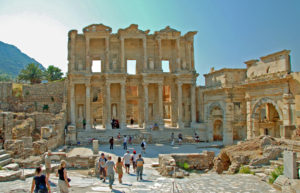
Remains of Ephesus Library (Photo by Don Knebel)
The elaborate façade of the Ephesus library recalled the area behind the stage of Greek theatres, respecting Celsus’ Greek background. Four pairs of Corinthian columns flanked three doors. Windows above the doors faced the morning sun, encouraging library users to rise early. The columns on the façade’s corners were shorter than those in the center, reportedly to create the illusion of a larger building. Niches between the columns held female statues representing wisdom, virtue, insight and knowledge, qualities associated with Celsus. Up to 12,000 scrolls were stored in niches along the interior walls, with double walls protecting the scrolls from the elements. The body of Celsus was interred in a marble sarcophagus beneath the main floor.
The interior of the library and its collection of scrolls were destroyed in 262, either during an attack by Goths or by an earthquake. In the fourth century, the building, its original façade repaired, was repurposed as a nymphaeum. The façade was later destroyed and the building lay in ruins until the 1970s, when the façade and portions of the interior were reconstructed from the rubble. During excavations, the tomb of Celsus was rediscovered, where his body had lain undisturbed for eighteen centuries and where it still remains.
Comments are closed.